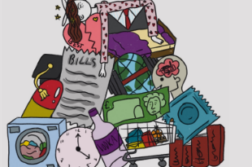The popularity of social media influencers has undoubtedly soared in the last few years, as platforms including Instagram and YouTube have seen a rise in influencer content across their feeds. These posts often come in the form of hauls, or ‘Get Ready With Me’ videos, where social media personalities will showcase their wealth of new items, often as a form of brand promotion.
I have recently found myself falling into the holes of influencer Instagram pages, tapping their images to see where each piece of their outfit is from and how I can get it for myself. This first came from wanting an opinion about a product before I spent my money on it; does that foundation actually cover blemishes? Will that ASOS top really be good quality? How will it look on my body type? When influencer culture first began to grow roughly ten years ago, they managed to fill this crucial gap in the consumer market that is still rapidly developing even a decade later.
I have always had a love for clothes, and, as a result, shopping. However, I have never been one to make unnecessary, extravagant purchases – that was, until the pandemic began. My increased interest in influencers began during the first UK lockdown last March, when a dip in university work combined with being housebound left me with little else to do aside from browsing social media. The carefully curated Instagram pages of influencers helped me to cling onto the glamour of pre-pandemic life and remind me of how much I used to enjoy getting dressed up and going outside of the house. I couldn’t help myself refreshing my favourite influencers’ pages to see their new clothing items, which would then lead me to spend hours browsing online shops and adding countless items to my baskets, which, had it not been for influencers, I would probably never have been aware of. It is no surprise that we saw a boom in e-commerce as a result of the COVID-19 pandemic, as the world’s increased screen times lead shoppers to find a new way to satisfy their spending habits, which I fell victim to.
Despite the pandemic creating absolutely no need for new clothes, the ease of online shopping and next-day delivery deals made it difficult to resist the excitement of having brand new items turn up at your door every week. It seems that influencers are also having a similar experience, as they are able to purchase (or be gifted) large amounts of brand new products to promote to their followers, which consumers could subsequently add to their own collections. This also means that most influencers are pictured in an entirely new outfit every time they post a photo, and no clothing items are ever repeated. Watching this attitude towards clothing unfold in front of me, it became normal for me to place large online orders; I felt justified to continue shopping because the people I was following on social media were doing it too. The actions of influencers only exacerbated my personal struggles with lockdown and my frustration over not being able to do one of the things I thoroughly enjoy: getting dressed up and going out in an outfit that makes me feel great. Perhaps in ‘normal’ life these habits wouldn’t have seemed so bad, as I could justify my purchases with the fact that they would be worn and used. However, the piles of new things I have accumulated in the last year, but that have never ventured outside of the house, are a reminder of the money I have wasted for things I never needed in the first place, but that my social media feeds convinced me I couldn’t live without.
The problem I have found with influencer culture is that social media stars occupy a grey area between celebrity and regular consumer. This is when it becomes difficult to acknowledge the difference in their accumulation of items than my own; I wouldn’t compare my wardrobe and skincare to Beyoncé’s, but it doesn’t seem a stretch to equate it to a young influencer the same age as, or younger than, me. Whilst ASA advertising guidelines ensure that it is clear which products are gifted or sponsored by brands, it doesn’t remove the feeling of longing that consumers are left with. After all, this is entirely the intention of brands who utilise influencer marketing. Although I have reached a point where I can recognise these intentions of influencers and appreciate that their habits should not correlate to mine, it is a tough habit to break. This is perhaps something that most shoppers have struggled with over the last 12 months, as you have to learn to balance your social media consumption and personal finances with the often unachievable lifestyle that influencers promote.



